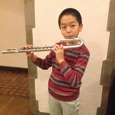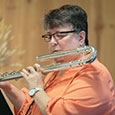With the explosion of flute choirs and flute orchestras throughout the world, teachers have both the joy and the challenge of introducing alto, bass, and even contrabass flutes to younger and younger students.
.jpg)
I purchased my first alto and bass flutes in the early 1980s and now have three altos, three bass flutes, a contrabass and an Eb flute. I use each of them every week at lessons, flute choir rehearsals, and in recitals. They are played by everyone – flutists of all ages and levels. They are kept scrupulously clean with a spray meant for sterilizing brass mouthpieces, and I shift personnel and instruments frequently.
-5(3).jpg) Getting Started
Getting Started
Teachers can safely introduce the alto flute into lessons when students’ arms are long enough for a curved head alto, their physical balance is secure holding a C flute, and they have the breath support to hold a steady pitch for longer than 15 seconds. Bass flutes need slightly longer arms (or stronger arms) and controlled finger action, but they too can be introduced to flutists as young as 9 or 10 years old.
As you place a big flute into a student’s hands, position the left hand first. Be sure to hold the weight of the flute yourself and use your free hand to gently curve the student’s first finger knuckle into its support position. Then place the left and right thumbs and curve the left fingers onto the B, A, G, and G# keys. Still keeping the weight in your control, reposition the right-hand thumb first and then place the pinky on the D# key, followed by the D, E, and F keys. Younger students do very well with the newer, light-weight basses and altos, made from a composite plastic. Heavier, all silver models are quite hefty and can lead to injuries such as tendonitis.
Alignment of Big Flutes
There are two basic schools of thought on this subject. Some players like the 90-degree angle (vertical or horizontal) but I prefer a 45-75-degree angle, towards the chin. It distributes the weight more evenly (better fulcrum) and allows the hands more freedom of movement. Make sure the footjoint is placed for easy reach of the C and C# keys.
First Sounds – Less is More
I caution students who are new to playing the big flutes that their first sounds should be gentle and relaxing. The lower frequency of the alto and bass tones do not need a fast air stream. It helps to tell students to exhale gently, instead of blowing or to calmly allow warm air to pass over the embouchure hole. Tweak the sound by adjusting the embouchure plate. Encourage students to roll out and place the embouchure plate low on the chin, keeping the jaw open and relaxed.
I use a low G as a first note, but any left-hand note will do. Have a treble clef staff handy to show them where the tone they are making appears on the staff. Once students make a sound, allow them to explore other fingerings and even other octaves. Keep your own hands free to assist in supporting the instrument if the student tires or bobbles. Begin with long tones, then progress to quarter notes up and down a short scale in one breath. Stay in the lower register until the students becomes comfortable, then attempt the middle range. Check the chin to make sure there is suppleness and looseness. Jamming the headjoint into the chin will severely limit range and even prevent high notes from speaking.
Flute Pegs
There are many companies producing multiple flute pegs. Make sure your flutes have a secure place to rest when not in use. If possible, make big flutes available for practice before and after students’ lessons or flute choir rehearsals. If students show interest and affinity for playing alto or bass flute, assign them scales, etudes, and solos at their lessons. Many high school flute choir competitions are asking students to record on bass or alto flute as well as on C flute.
Adding big flutes to your studio and flute choirs broadens the opportunities for artistic expression. The lower colors balance the piccolo and C flutes in the flute choir repertoire. Lower flutes give flutists experience on an inner part or bass line, and this develops the ear and musical awareness.
Low Flute Resources
The National Flute Association has an active Low Flutes Committee that is dedicated to promoting the playing, teaching, repertoire, commissions and appreciation of the big flutes.






